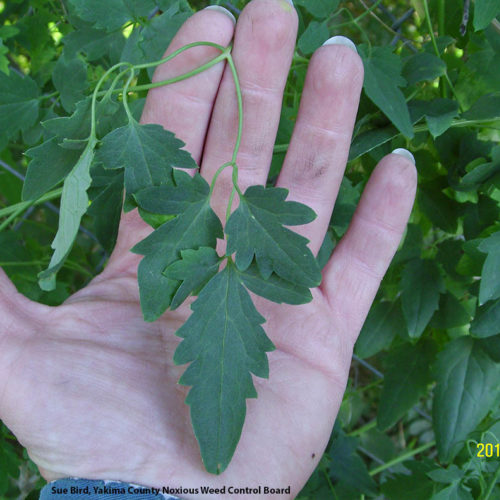Oriental Clematis
Clematis orientalis

Family: Ranunculaceae
Other Common Names: Chinese clematis, oriental virginsbower, orange peel clematis
Weed class: A
Year Listed: 2012
Native to: Native to Eurasia
Legal listings:
This plant is also on the Washington State quarantine list. It is prohibited to transport, buy, sell, offer for sale, or distribute plants or plant parts of quarantined species into or within the state of Washington or to sell, offer for sale, or distribute seed packets of seed, flower seed blends, or wildflower mixes of quarantined species into or within the state of Washington. Please see WAC 16-752 for more information on the quarantine list. For questions about the quarantine list, contact the Washington State Department of Agriculture's Plant Services Program at (360) 902-1874 or email PlantServices@agr.wa.gov.
Why Is It a Noxious Weed?
It forms dense infestations that outcompete native plants and can kill small trees. It is listed as a noxious weed in Colorado, where it is reportedly difficult to control. It has the potential to establish in a variety of habitats in Washington.
How would I identify it?
General Description
It is a moderately vigorous, deciduous climber or a scrambling shrub that typically forms a mass of stems and grows up to around 27 feet long.
Flower Description
Flowers are single or in clusters of 3 to many. Flowers are on stems up to around 4 inches long and have 4 yellow to yellowish green sepals (look like petals). Flowers to about 1 inch long. Yellow sepals spread outward and may curve back at maturity.
Leaf description
Leaves are opposite on stems, pinnately compound, with five to seven leaflets. Leaflets have variable size, shape and margins.
Stem description
Stems grow up to 27 feet long and are slender and ridged.
Fruit Seed Description
Seedheads are a rounded cluster of single seeded achenes. Achenes have hairy styles attached and are around 1 to 2 inches long. Seedheads look like pom-poms.
Where does it grow?
Habitats it grows in includes gullies, riverbanks and streambanks, roadsides, open woods, steep hillsides and irrigation canals. Please click here to see a county level distribution map of Oriental clematis in Washington.
How Does it Reproduce?
It reproduces by seed and vegetatively by layering and sprouting from root crowns.
How Do I Control It?
General Control Strategy
In Colorado it is noted to be difficult to control once it is established. It can establish in hard to access areas such as steep slopes with loose rocks, making control of some infestations difficult and expensive.
Mechanical Control
Colorado recommends hand pulling or digging the plant when the soil is moist, making sure to pull all the roots and carefully bag plant material so as to not scatter seeds.
Biological Control
There are no known biological controls.
Herbicide Control
Please see our written findings and refer to the PNW Weed Management Handbook, or contact your county noxious weed coordinator.
For More Information
See our postcard for early detection information about oriental clematis.
See our Written Findings for more information about oriental clematis (Clematis orientalis).
Invasive Plant Atlas information on Clematis orientalis

















